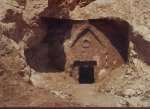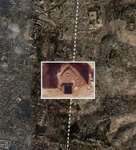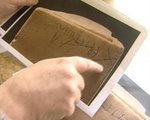Look deeper than bare bones
By Sarah Cash
http://media.www.westerncourier.com/media/storage/paper650/news/2007/03/07/Opinion/Look-Deeper.Than.Bare.Bones-2762301.shtml
Every year the entertainment industry produces a new movie or research finding related to one of the most harassed religions in the world - Christianity. Dan Brown's novel-turned-movie "The DaVinci Code" and fragments of the Gospel of Judas are some of the most recent religion-based scandals offered by the media. This past Sunday, the Discovery Channel aired the newest; a documentary called "The Lost Tomb of Jesus."This film, produced by History Channel personality Simcha Jacobovici and "Titanic" director James Cameron, made several claims that had both Christians and archeologists in an uproar. After watching the film, it was easy to see why.The film's premise centered on the discovery of six labeled ossuaries, or bone boxes, which were first uncovered in one tomb in Talbiot, Jerusalem, in 1980. The boxes, according to the film, were singular because of the names inscribed on their sides: Jesus, son of Joseph; Maria; Jose (Joseph); Matthew; Mariamne e Mara (possibly Mary of Magdalene); and Judah, son of Jesus.These names, all found in the New Testament of the Bible with relation to Jesus of Nazareth, led to the film's suggestion that researchers had uncovered his family tomb, which further led to the "probability" of Jesus not only being married to Mary Magdalene and fathering a child (Judah), but of his Biblical resurrection being only spiritual, since the presence of an ossuary denotes bones being left behind.However, the film appeared to use only two determining factors as its basis. First, DNA tests of bone fragments from the Magdalene and Jesus tombs determined that the two inhabitants were not from the same matrilineal descent; the documentary suggests that since tombs included only family members, this means the two people must have been married. One might also be interested to know that these were the only two ossuaries that received DNA testing, which Jacobovici confirmed in a discussion entitled "A Critical Look" that was held on Discovery immediately following the film's premiere.The second piece of evidence is four statistical studies the filmmakers commissioned. According to Jacobovici's statement in a washingtonpost.com article, the studies determined that the odds of the parti cular names all appearing in a single family tomb from the first century are "somewhere between 600 and 2.4 million to one."Those are the film's claims in an abbreviated nutshell. Discovery.com/tomb has additional film clips and articles for anyone whose interest is piqued. Hopefully it is clear, however, that the amount of evidence is not only minimal but also shamefully shallow, especially for a film that was given $3.5 million from Discovery, according to newsweek.com.While archeologists were disgusted at the lack of thorough testing and the film's dramatic portrayal of "history," another group was even more outraged, and here is where Christians come into play. "The Lost Tomb of Jesus" suggests that if this information is true, a fundamental belief of Christians may be overturned. Christians believe that after Jesus was crucified and buried in a sealed, temporary tomb, he was resurrected on the third day and left nothing behind besides burial cloths. These beliefs, and the idea that Jesus returned in human form to prove his divinity, are found numerous times in the New Testament of the Bible.Now that all of this background information is on the table, more important issues can be raised. Leading professionals in the fields of archeology and religious studies both denounced the credibility of the documentary, stating in the "Critical" discussion following it that they found no reason to believe any of the claims were true. With, to use a term of Sunday evening, so much weight against a "chain of ifs," why has the media blown this film out of proportion?Headlines such as "Christians Split Over Claim of Christ's Tomb" (newsweek.com) are completely untrue and only perpetuate an unnecessary divide between a group of people trying to uphold its beliefs and the media. It's a common thought (and a Biblical reference) that faith is believing in things unseen, so why would the faith of true Christians be challenged over dubious physical evidence? Believers have been fighting the same war since fossils of dinosaurs surfaced, suggesting evolution. The host of the "A Critical Look," Ted Koppel, ended the spirited discussion with a gem of a statement: "What happens to faith in the face of inconvenient truth?" He asked. "Not much."To be fair, history is always worth a second study, and the producers of the documentary have every right to advance physical research, especially when it really is as fascinating a coincidence as this. Why do "journalists" such as those who worked on this film, however, have to turn information into sensationalism? Whose interest does it really serve to add dramatic music and re-enacted, first century scenes with paid actors? It's asking the old question of how fact and fiction are kept apart. Perhaps the American public watching "education television" should be wary of what they are seeing.One of the professors who spoke after the film, Judy Fentress-Williams from the Virginia Theological Seminary, made a terrific point. She said that Christians need to be critical of what they believe and watch, especially with programs like this, which are selective in what they present. However, this can be applied to any person participating in any media. Think for yourself. Consider who interprets information and what personal beliefs may be at stake in believing it. History proves that people thrive on sensationalism, but it doesn't mean we should blindly believe in it.





































No comments:
Post a Comment